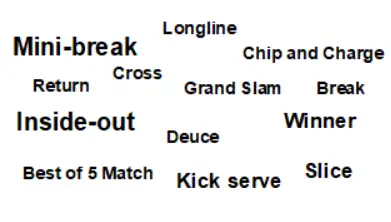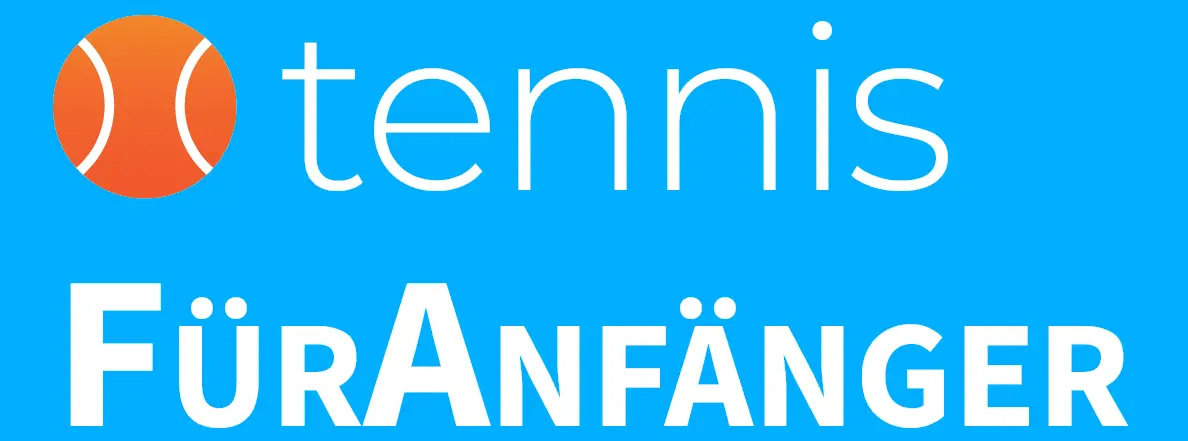Tennis glossary
The most important tennis terms explained in an understandable way
What exactly is a champion tiebreak? And how does it differ from a normal tiebreak? And what is actually a Grand Slam tournament?
No matter if you are a beginner, an advanced player or a professional: We all learn new tennis terms again and again, which are unclear to us or which we haven’t stumbled over in our tennis career so far. In order not to lose the overview in the tennis jungle, we have created a glossary sorted from A to Z. This serves as a supplement to our tennis playing overview page.
The tennis glossary is regularly updated and supplemented: So it’s best to save it in your bookmarks and favorites list! So you always have a digital reference book at hand.
You can’t find a term? Then get in touch with us. We will be happy to add it to the glossary.
A
Ace is the name given to a serve in tennis that comes up in the right court but is not touched by the opponent.
In tennis, the advantage server is the score after a deuce and a point won by the server.
In tennis, the advantage receiver is the score after a deuce and a point won by the receiver.
B
A tennis stroke is called backhand if it is played with the back of the stronger hand. For right-handers on the left side and for left-handers on the right side. The backhand can be played both one-handed and two-handed.
In tennis, a bagel is a 6:0 set.
The baseline delimits the back of the tennis court on both sides. If a ball lands behind the baseline, the point is lost for the hitter.
A ball kid in tennis is a person who usually picks up the balls from the pros and also throws them back to them. Often it is children, but it can also be adults.
In tennis, a ball toss is the act of throwing the ball up on serve.
A Best of 3 match is a tennis match where the winner must win 2 sets and thus a maximum of 3 sets are played.
A Best of 5 match is a tennis match where the winner must win 3 sets and thus a maximum of 5 sets are played.
A lost service game is called a break in tennis.
C
Career Grand Slam is defined as winning all 4 Grand Slam tournaments in tennis in active career.
In tennis, a chair umpire is the official umpire who sits on an elevated chair at net level and umpires the match.
In tennis, a champions tiebreak, also often called a match tiebreak, is a deciding set in the event of a set being tied. This often replaces a normal deciding set in amateur tennis. The champions tiebreak is considered won as soon as a player has won 10 points with at least a 2-point lead.
Cross refers to a tennis stroke direction where the ball is played diagonally back into the field.
In tennis, a chip and charge is an aggressive return with a direct attack to the net to put the server under pressure early in the rally.
Counting is the term used to describe the structure in tennis, which is based on points, games and sets.
D
In tennis, a deuce is the score of 40-40 in a service game.
Doubles is a same-sex match two-on-two.
Double fault is the term used to describe two service errors in a row in tennis.
Doubles court is the term used to describe the court area in tennis into which the ball is allowed to bounce during doubles.
In tennis, a double bagel is a 6:0, 6:0 final score.
In tennis, double-handed is a stroke with two hands on the racket.
A drop-shot is a tennis stroke that is played directly behind the net – while the opponent is usually still behind the baseline.
E
F
A tennis stroke is called forehand if it is played with the stronger hand only. Right-handed players use the right hand and left-handed players use the left hand.
A forehand inside-in in tennis is a forehand from the backhand side longline to the forehand side of the opponent. The player’s own backhand is bypassed in the process.
A forehand inside-out in tennis is a forehand from the backhand side cross onto the backhand side of the opponent. The player’s own backhand is bypassed in the process.
A foot fault in tennis means that the server has touched the line with one foot. The serve is officially considered a fault. However, in amateur tennis, where the game is played without umpires and line judges, a foot fault is almost impossible to prove.
G
In tennis, a game is defined as a completed service game that is decided by winning several individual points.
A Golden Slam is defined as winning all 4 Grand Slam tournaments and Olympic gold in tennis in one year.
A Grand Slam is defined as winning all 4 Grand Slam tournaments in tennis in one year.
Grand Slam tournaments are the 4 most important tennis tournaments in the world. These include the Australian Open, the French Open, Wimbledon and the US Open. They each take place once a year.
Forehand and backhand are considered the ground strokes in tennis.
H
In tennis, Hawk-Eye is a computerized system for tracking the tennis ball and making out-of-bounds decisions.
I
An inside-in in tennis is a forehand or backhand from the other side down the line. The original side is bypassed in the process.
An inside-out in tennis is a forehand or backhand from the other side cross court. The original side is bypassed in the process.
J
Jeu de Paume (“palm”) is considered the predecessor of today’s tennis – it originated in the High Middle Ages in northern France.
K
In tennis, a kick serve is a serve with a lot of forward spin and some sideways spin, which bounces correspondingly high and is often played both as a tactical variation on the 1st serve and as a safe variation on the 2nd serve.
L
Lob refers to a tennis stroke that is played high and long – usually over the opponent standing at the net – into the open court behind it.
Longline refers to a tennis stroke direction where the ball is played straight back into the court parallel to the sideline.
In tennis, a line judge is a person who watches a line and calls out loudly as soon as the ball crosses the line and lands out of bounds. They assist the chair umpire.
M
In tennis, a mini-break is the winning of a point on an opponent’s serve in a tiebreak.
Mixed is a match two-against-two, where both pairings consist of woman and man.
N
Net roller is the name given to a ball in tennis that touches the net but still bounces from there to the opponent’s side.
O
Overgrip is the name given to a grip tape in tennis, which is wrapped over the basic grip tape of the tennis racket.
P
Q
Qualification is called a preliminary round before the actual tournament in tennis, where the winner of the qualification is allowed to participate in the tournament.
R
Winning the opponent’s service game directly after losing a service game is called a re-break. Two breaks in a row, so to speak.
Return refers to a tennis stroke that directly follows a serve.
In tennis, a return game is the game played from the point of view of the player returning the ball.
S
In tennis, a set is defined as a win of 6 games with at least a 2 game lead. At the score of 5:5 the set is played to 7.
A serve is a tennis stroke that opens the rally. Therefore, the serve is often considered the most important stroke in tennis. In a match, a player always has two attempts to hit the serve into the right court.
In tennis, a service game is the game of the server.
Serve and volley in tennis is a direct net attack after the serve, so the 2nd ball played is a volley.
In tennis, single-handed is defined as a stroke with one hand on the racket.
A single court is the area of play in tennis where the ball is allowed to bounce.
Singles is a one-on-one match.
Slice is a type of stroke in which the tennis ball slows down again as it bounces in the opponent’s court due to a backspin.
In tennis, a slice serve is a serve with a lot of side spin, which slides out to the side accordingly and is difficult for the opponent to play.
Smash is the name given to a tennis stroke when a ball is played overhead during an exchange of balls, similar to a serve.
T
The area between the net and the T-line is called the T-field or service area. The ball must be played cross-court into the T-field when serving.
The T-line delimits the tennis court to the rear during the serve. The ball must land in front of or on the T-line when serving.
In tennis, a tiebreak is the decision of a set at the score of 6:6. The tiebreak is considered won as soon as a player has won 7 points with at least a 2-point lead.
Topspin is a type of stroke in which the tennis ball accelerates again as it bounces in the opponent’s court due to a forward spin.
A trial membership in tennis is a club membership for a reduced annual fee in the first year. As a rule, the trial membership becomes a normal membership at the end of the first year without cancellation. Tennis clubs use trial memberships to try to attract new club members.
In tennis, a try-out session is the first time you join a training group. Afterwards, you can decide whether you want to play regularly.
U
Unforced error is the term used to describe a mistake in tennis where the player makes an avoidable error without being under pressure.
V
Volley is the name given to a tennis stroke that is taken directly from the air – without first bouncing on the ground – during the rally.
W
X
Y
Year End Number 1 is the name given to the world number one in tennis who ends the year as number 1.

